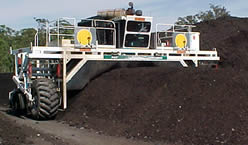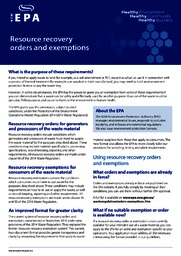What is compost?
When organics
material breaks down, beneficial products are formed that can increase soil
quality and productivity and yield many climate change benefits (PDF 947KB).
In nature, organics
material gradually decomposes and returns nutrients back to the soil. Licensed
composting processors use various systems to speed up this natural process.
Composts today are
made from materials such as food and garden organics from household green bins,
green waste from commercial landscaping activities, or commercial food wastes.
Different composting technologies can be used to
produce quality, fit-for-purpose products. These technologies include aerobic
composting systems, turned windrow systems, aerated state pile and in-vessel
systems.
Turned windrow
 Mechanical turning of an organics windrow
Mechanical turning of an organics windrow
This composting system uses horizontal piles, formed by a
front-end loader or windrow turner, and aerated by mechanical turning.
The piles are generally 1.5 to 3 m in height, their length limited
by composting pad size.
Aerated static pile
This composting method uses a blower to aerate a free-standing
pile, moving air through perforated pipes located beneath the pile.
In-vessel
In this system composting takes place in an enclosed chamber
or vessel, which typically controls the composting process by regulating the
rate of mechanical aeration.
Aeration helps remove heat, and control temperature and
oxygenation. The blower used to aerate the chamber can operate in a positive
(blowing) and/or negative (sucking) mode. The aeration rate can be controlled using
temperature, oxygen or carbon dioxide feedback signals.
Anaerobic digestion
This organics treatment system uses microbial action to
decompose organics material in a solid, semi-solid or liquid phase in the
absence of oxygen. Part of the organics fraction is converted to carbon dioxide
and methane.
Systems may include covered lagoons, covered stabilisation
basins, or completely enclosed agitated or non-agitated towers.
Methane recovered must be purified to remove carbon dioxide,
in most cases, if it is to be burned for energy.
Anaerobic digestion mostly occurs at moderate (mesophilic)
temperatures. In some systems, the methane recovered is used to heat the
reaction chamber to higher (thermophilic) temperatures to speed up the
digestion process.
Vermiculture
In vermiculture composting processes, organic matter is
broken down primarily by worm species.
Commercial vermiculture systems include
- windrows or beds
- stackable trays
- batch-flow containers
- continuous flow containers
The systems described above relate mainly to the processing
of source-separated organic materials. Some facilities in NSW accept food and
garden organics mixed in the red lid bins from municipal, commercial or
industrial collections.
Alternative waste treatment facilities remove
non-compostable and recyclable materials before processing the remaining
organics fraction. They use patented processing technologies, such as a
rotating drum, aerated static pile curing and in-vessel composting.



